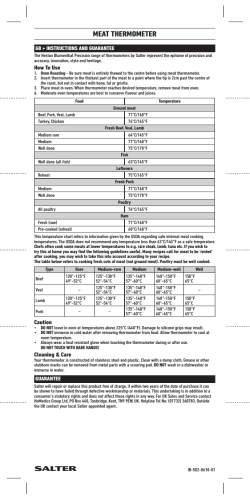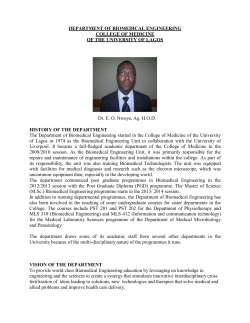
BME, Department of Hydrodynamic Systems Measurement technique of process www.hds.bme.hu
BME, Department of Hydrodynamic Systems www.hds.bme.hu Measurement technique of process 3 Thermometer’s response to step function Thermometer’s response to step function Measurement technique of process (BMEVGAG03) 1. Aim of the measurement The aim of the laboratory measurement is to determine the properties (time constant and rise time) of a thermometer as a first-order system according to the measurement data. 2. Description of the measurement The thermometers can be described by a first-order differential equation, see (1). y y K Ft , (1) where τ is the time constant of the system, F(t) is the excitation (output function), and y is the describing function of the system which is the temperature, actually. The equation can be simplified because the excitation is a step function: y y K A , (2) where A is the amplitude of the step function (constant value). Because of the initial condition (y(t=0) = y0), the solution of the differential equation is: భ yt K A y K A eିഓ୲ . (3) For the further examination of the system, an error function can be also defined: Γt ୷ሺ୲ሻି୷ಮ ୷బ ି୷ಮ భ eିഓ୲ ), (4) where yஶ K A, which is the steady response. With this error function, eq. 4, the rise time can be also defined: Γt 0,1. During this time, the curve is approaching 10 % to the steady response. భ Table 1 contains the typical theoretical (Γt eିഓ୲ ) values of the error function (see eq. 4.). t/τ [-] Γ [-] Γ [%] 1 2 3 0,3679 0,1353 0,0498 36,79 13,53 4,98 0,1 10 2,303 rise time Table 1: typical values of the error function. With the help of the natural logarithm of the error function, a linear relationship can be found with the time: ଵ ln Γt ఛ t . 1 (5) BME, Department of Hydrodynamic Systems www.hds.bme.hu Measurement technique of process 3 Thermometer’s response to step function This can be delineated in a figure where the tangent of the curve is the τ time constant. With this value, the rise time can be calculated and with the help of the eq. 3, the processing can be described. (Note: in this examined system, t is the time in second, y is the temperature in unit °C which is called T in the section 4. 3. The experimental set-up Figure 1 presents a sketch of the experimental set-up. The heated up water (≈60…80°C) can be found in a tank (4). With the thermometer (3) measured signal is transmitted across a data processor device (2) to the computer (1) in which the data are processed with the help of the Catman software. The measurement begins with the starting of the software, and then suddenly the thermometer is putted into the tank. Some seconds later, the steady state is already existed; the data acquisition can be stopped and the measured data can be saved. 1. Figure: The sketch of the experimental set-up (1: computer, 2: data processing unit, 3: thermometer, 4: water tank). 4. Post processing of the measured data The measured signal is appr. 4-6 seconds long with the sampling frequency 4800 Hz, which is saved in a .txt file (form: [time, temperature]). These data can be imported into a software (eg. MS Excel), in which they can be post-processed. In Figure 2, typical measured data are presented; left side: full measured range, right side: only the warming range. 2. Figure: Thermometer to step function (left side: full measured range, right side: emphasized only the warming range). The moment of the beginning of the step function has to be searched “manually”. (It can be found with detecting the point when the slightly temperature fluctuation is turned into a rapid rise.) In this 2 BME, Department of Hydrodynamic Systems www.hds.bme.hu Measurement technique of process 3 Thermometer’s response to step function moment, the time has to be zero, i.e. the timescale has to be restarted and a new (t’) timescale has to be introduced. (Note: the time-step is not changed.) With the help of the eq. 4, an error function Γt′ can be defined. In our case, Tஶ can be approximated with steady state temperature (eg.: average of the temperature between t=2,5 – 3,5 second) and T is the initial temperature (eg.: average of the temperature between t=0 – 1 seconds), see left side of the Figure 1. Figure 3 presents the error function. 3. Figure: The error function in the warming range (with the help of t’ timescale). The natural logarithm of the error function (eq. 5) is presented in the left side of the Figure 4. The linearity of the system can be seen in the early part of the warming process, where the temperature difference (between ஶ and T(t)) is quite high. When the temperature approximates the value of Tஶ , other disturbances are also dominating (eg.: the temperature distribution in the tank is not homogeneous) and the linearity decreases. 4. Figure: The natural logarithm of the error function (left: in the warming range, right: the unequivocal linear range and the fitted trend line). The unequivocal linear range can be chosen manually (with a considerate “engineering sense”), and a trend line can be fitted to this curve (eg.: linear trend line in MS Excel, which applies the Ordinary Least Squares), the Origin let be the (0,0). It can be observed, that the tangent of this curve is the invert of the 1 time constant, see eq. 5. The theoretical warming curve can be calculated with the help of τ time constant and the eq. 3., see the left side of Figure 5., and it is also presented in a dimensionless form in the right side of Figure 5. The theoretical values of the rise time can be calculated from the last row of Table 1. with the help ofthe former calculated τ time constant. The measured values of the rise time can be also estimated with the help of eq. 4., and the measured data. To this rise time, a temperature value can be 3 BME, Department of Hydrodynamic Systems www.hds.bme.hu Measurement technique of process 3 Thermometer’s response to step function determined from the measured data according to the eq. 4. This point is also presented in the figure 5. 5. Figure: The measured and the theoretically determined warming curves (left: timescale: t’ [s], right: timescale: t’/τ [-]). The report has to contain the compulsory requirements (see on the website) and also the followings: • • • A brief introduction of the applied mathematical methods. In this description presented figures (with own measured data). The values of τ time constant and rise time (theoretically calculated and measured also). 5. Applied devices • thermometer: • data processing device: 6. Questions • Define a first-order differential equation! • Define the solution of a first-order differential equation if the excitation (output function) is a step function! • Define an error function in the case of a first-order system! • How can be determined the τ time constant with the help of the measurement data of a firstorder system? 4
© Copyright 2025

















